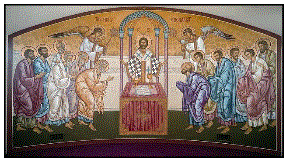There are many ways in which one can approach the history of the development of the Divine Liturgy. It seems that an appropriate way is to approach in a structural and historical manner, that is, to identify and isolate individual liturgical structures or units and then trace their history as such rather than attempt to study the entire ritual as a unit in each historical period. Historians of the Divine Liturgy have noted that liturgies tend not to grow evenly. Rather, their individual structures possess a life of their own.
The first structure that needs to be considered is the introduction to the Liturgy of the Word – the particular ritual that leads up to the readings. Our present structure is:
Initial Blessing
Great Litany and Prayer I
Antiphon I
Hymn of the Incarnation
Small Litany and Prayer II
Antiphon I
Little Entrance With the Gospel
Entrance Prayer
Tropars & Kondaks
Trisagion Prayer and Chant
Procession to the Throne
Greeting: Peace to All.
- A) The Blessing and Great Litany
The opening blessing “Blessed is the Kingdom” did not appear until the ninth century. In the primitive liturgy, such intercessions (petitions) only occurred after the readings, thus safeguarding the priority of the divine action in the order of the service. Only after God speaks to us His Word do we respond in psalmody and prayer. As a matter of fact, the Great Litany was once found just before the transfer of gifts. But following a tendency observable in almost all liturgical traditions, these petitions were either suppressed or moved up to the beginning of the Liturgy of the Word.
In the ninth century we find the Great Litany before the transfer of gifts and also after the Little Entrance, just before the Trisagion (i.e., at the old beginning of the Liturgy). By the end of the ninth century, it is found also before the Antiphons (i.e., at the new beginning). In the 12th century it disappears from its original place in the prayers of the faithful. It was the original litany of the faithful which was concluded with the Prayers of the Faithful. In the 13th century it disappears before the Trisagion, remaining only where we still find it today.
A fascinating history!

